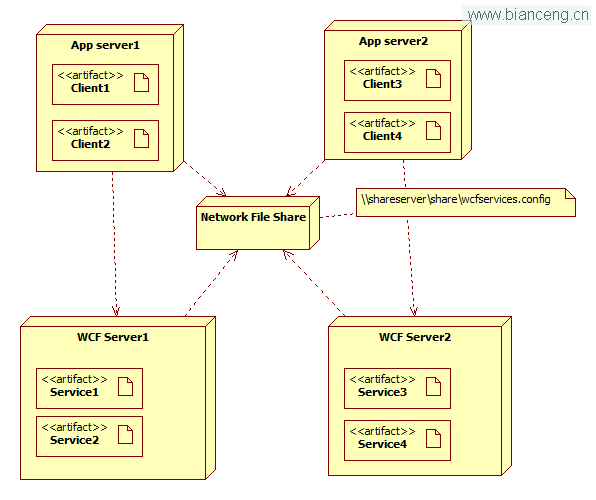WCF,很好,卻又麻煩,很多時候不想用WCF的原因就是:用這個真麻 煩...
麻煩的地方,比如:
一堆一堆的服務配置,散落在一個一個的folder下,更新系統時容易出錯
客戶端除了要知道WCF Contract外,還要知道服務Provider所在位置
所以想了個辦法來簡化這些,主要思路是:
加入Internal Communication Service,簡稱ICS。用來插入自定義的中間層
編寫一個Service Locator Service,用來將WCF服務提供者信息抽取統一保存 ,如:url, endpoint類型,做到wcf服務提供者位置無關性
完成後,WCF客戶端(包括WCF服務內部調用了其他WCF服務的服務...)調用代 碼會變成如下方式:
//不支持事務的調用方式
IUser userSrv = ICSFactory.Create<IUser>();
var result = userSrv.GetUserName("1", "2",
"3");
ICSFactory.Close(userSrv);
//支持事務的調用方式
string result = string.Empty;
using (TransactionScope ts = new TransactionScope())
{
IUser userSrv = ICSFactory.Create<IUser>();
IAdmin adminSrv = ICSFactory.Create<IAdmin>();
result = userSrv.GetUserName("1", "2",
"3");
result = adminSrv.CheckPermission(100).ToString();
ts.Complete();
ICSFactory.Close(userSrv);
ICSFactory.Close(adminSrv);
}
WCF客戶端的配置信息去哪了呢? A:在appSetting中,有個key,用來表示服 務配置信息文件所在路徑,如:\\fs\root\a2d.service.config,配置文件如下 :
<?xml version="1.0" encoding="utf-8" ?>
<A2D>
<ServiceLocator>
<Service ContractNamespace="DEsbInterface"
Contract="IUser">
<Url
EndpointType="Tcp">net.tcp://192.168.1.100:9999/usersrv<
;/Url>
</Service>
<Service ContractNamespace="DEsbInterface"
Contract="IAdmin">
<Url
EndpointType="Tcp">net.tcp://192.168.1.100:9998/adminsrv&l
t;/Url>
</Service>
</ServiceLocator>
</A2D>
如果調用WCF服務的客戶端只有一個程序,就沒多大用了,但是如果有很多客 戶端程序,那就有用了,如下場景:

4台server都作為客戶端進行WCF服務的調用
ICS原理:
在本例中,ICS其實就是ICSFactory,用來建立WCF服務代理,通過代碼方式加 入binding、address、transaction信息,底層調用的是ChannelFactory來建立通信,代碼如下:
public class ICSFactory
{
/// <summary>
/// 創建WCF服務代理對象
/// </summary>
/// <typeparam name="T">WCF的Contract類型</typeparam>
/// <returns></returns>
public static T Create<T>()
{
string contractNamespace = typeof(T).Namespace;
string contract = typeof(T).Name;
//根據WCF Contract信息找到相應的位置信息
Location location = ServiceLocator.Locate(contractNamespace, contract);
//生成綁定信息
NetTcpBinding binding = new NetTcpBinding();
binding.ReceiveTimeout = new TimeSpan(0, 10, 0);
binding.Security.Mode = SecurityMode.None;
binding.Security.Transport.ClientCredentialType = TcpClientCredentialType.None;
//事務設置
binding.TransactionFlow = true;
binding.TransactionProtocol = TransactionProtocol.OleTransactions;
//地址信息
EndpointAddress address = new EndpointAddress(location.Url);
//建立信道
T broker=ChannelFactory<T>.CreateChannel(binding, address);
//返回代理對象
return broker;
}
/// <summary>
/// Dispose代理對象
/// </summary>
/// <param name="broker"></param>
public static void Close(object broker)
{
if (broker == null)
return;
IDisposable disposable = broker as IDisposable;
if (disposable == null)
return;
disposable.Dispose();
}
}
Service Locator Service原理:
也就是ServiceLocator.Locate函數。
程序啟動時會根據配置讀取config文件的xml到內存對象中:Service、Url。 具體代碼略。
Locate函數的代碼如下:
/// <summary>
/// 根據Contract的命名空間及Contract名找到服務的真實地址信息
/// </summary>
/// <param name="contractNamespace"></param>
/// <param name="contract"></param>
/// <returns></returns>
public static Location Locate(string contractNamespace, string contract)
{
Service srv=null;
string key = string.Format("{0}.{1}", contractNamespace, contract);
if (!serviceCache.ContainsKey(key))
{
srv = FindService(contractNamespace, contract, srv);
serviceCache[key] = srv;
}
else
{
srv=serviceCache[key];
}
if(srv.Urls==null||srv.Urls.Count==0)
throw new Exception(string.Format("Service' url not found [{0}.{1}]", contractNamespace, contract));
Url url=srv.Urls.First();
Location location = new Location();
location.EndpointType = url.EndpointType;
location.Url = url.ReferenceUrl;return location;
}
private static Service FindService(string contractNamespace, string contract, Service srv)
{
List<Service> matchedServices = LocatorServiceConfiguration.Services.Where(t =>
t.Contract.CompareTo(contract) == 0
&&
t.ContractNamespace.CompareTo(contractNamespace) == 0
).ToList();
if (matchedServices == null || matchedServices.Count == 0)
throw new Exception(string.Format("Service not found [{0}.{1}]", contractNamespace, contract));
srv = matchedServices.First();
return srv;
}
查看本欄目